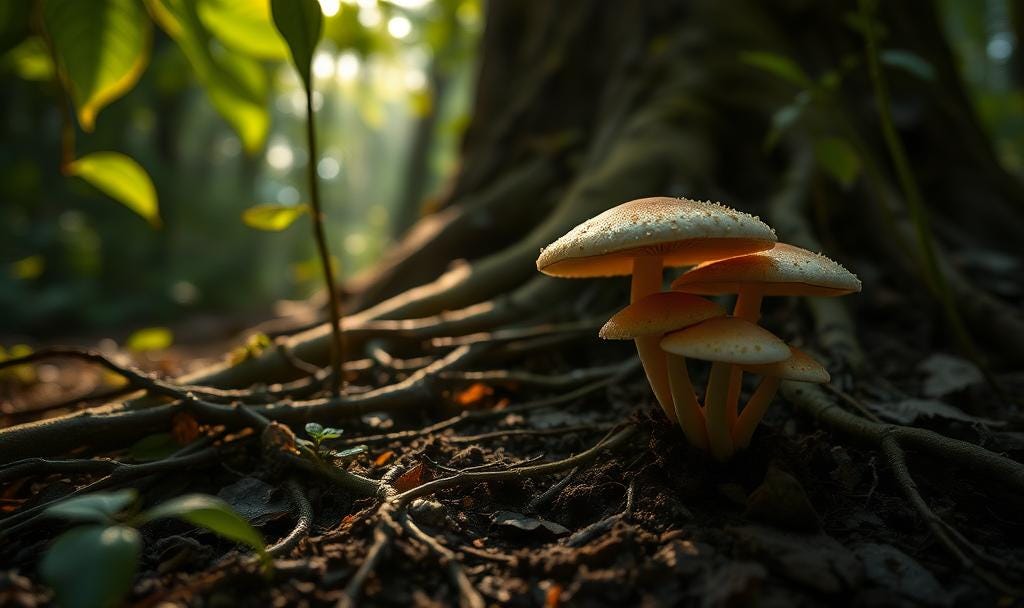Last April, after three days of steady spring rain, I stepped into our new orchard and found something magical had happened overnight. Dozens of mushrooms had erupted from the soil around our young apple trees, their caps gleaming in the morning light. I knelt to examine them, these visible fruits of an invisible network that had been quietly working beneath the surface for months or perhaps years.
In that moment, I felt a strange kinship with these fungi—organisms that dwelled at the boundaries of my understanding. For much of my life, I had been someone who prized clear categories and firm boundaries. But there in the orchard, examining these mysterious fruiting bodies, I recognized a profound truth about myself that had been unfolding through years of gardening and spiritual formation: I had spent much of my life running from connection rather than embracing it.
Necessary Dependence: The Seedling Stage
All trees begin as seeds, utterly dependent on the right conditions to germinate and grow. They require a delicate balance of water and warmth, protection from threats, and nutrient-rich soil. This initial dependence isn't weakness—it's the necessary first stage of development.
Human development follows a similar pattern. Our earliest years are marked by total dependence on caregivers. I was fortunate to have parents who provided reliable nurturing, even if emotional connection sometimes remained elusive in our stoic Southern household. Like a seedling drawing everything it needs from the soil that surrounds it, a child absorbs not just physical care but models for understanding the world.
When we purchased our home years ago, the realtor disclosed something after we'd placed our offer: the previous owner—a builder who had constructed this house for himself—had installed a massive gun vault and rifle range in the subterranean basement. The vault was bank-sized, reinforced concrete walls protecting an arsenal I had no interest in housing, despite my Navy training with 45-caliber pistols and M-16 rifles.
In what my family now recognizes as a quintessentially "me" decision—they joke that like the father in "My Big Fat Greek Wedding" who saw Greek origins in everything, I see theological metaphors everywhere—I transformed that weapon vault into an underground greenhouse. The space designed for instruments of destruction now nurtures life. Seeds germinate where ammunition once sat. The windowless concrete vault that once stored tools of death now captures life breaking through crusty soil, always reaching toward the artificial light I provide—much as we humans reach toward divine light.
The seedlings in this converted sanctuary each spring remind me of the necessary phase of dependence—their vulnerable stems and unfurling leaves completely reliant on my attentive care. There's something sacred about this mutual relationship: their dependence on me, my commitment to them. A tiny tomato needs no justification for requiring water and light; it simply receives what it needs to grow.
The Anti-Dependence Detour: The Isolated Tree
But somewhere along my journey from seedling to sapling, I took a defensive detour. Rather than moving naturally from dependence to healthy independence, I developed what my counselor would later help me identify as fierce anti-dependence—a reactive stance against vulnerability and connection.
This anti-dependence found philosophical reinforcement during my college years, when I discovered Ayn Rand and Milton Friedman. Their celebration of individualism and market efficiency seemed to validate my deep discomfort with needing others. I embraced neoclassical economics with religious fervor, finding in its axioms of rational self-interest a framework that transformed my emotional defenses into intellectual virtues.
My Naval Academy and nuclear submarine officer training further cemented this worldview. Leadership meant standing apart, making decisions without emotional entanglement. Efficiency meant eliminating unnecessary connections. Productivity meant measuring output against input in neatly quantifiable metrics. I cultivated a life that avoided "entanglements" that might slow me down or make me vulnerable—relationships that required reciprocity, commitments that couldn't be optimized for productivity.
Even my early gardening reflected this mindset. I approached my first garden beds like an engineering project, with spreadsheets tracking inputs and outputs. Each plant was an individual production unit, success measured by yield per square foot. I sought the most efficient spacing, the optimal fertilizer ratios, and the maximum productivity, unaware of the complex community beneath the soil that made growth possible.
When connection is perceived as entanglement, we miss the very networks that could nourish us.
Toward Healthy Independence: Finding Your Roots
As my naval career ended and my business career progressed, I gradually developed authentic independence—the capacity to stand on my own, make decisions, and face consequences. Yet even this independence retained an edge of defensiveness. I confused solitary strength with maturity, failing to recognize that true strength emerges through connection rather than isolation.
My garden became the unexpected teacher of this lesson. One summer, I decided to grow corn using the "Three Sisters" companion planting method I'd read about—corn, beans, and squash grown together as they had been by indigenous farmers for centuries. I planned the project with skepticism, my engineering mind doubting the efficiency of this seemingly chaotic approach.
To my surprise, the interplanted bed outperformed my neatly ordered single-crop rows. The beans fixed nitrogen for the corn, the corn supported the climbing beans, and the squash suppressed weeds with broad leaves. What looked like entanglement was actually mutual support. What seemed like inefficient chaos was actually resilient order.
Still, I regarded this as merely an interesting gardening technique, not yet recognizing it as a metaphor for what my life was missing.
Discovering Interindependence: The Mycelial Revelation
A few years ago, while researching companion planting and imagining the possibility of an orchard, I stumbled upon the concept of mycorrhizal networks—the vast underground systems of fungal threads that connect plants in seemingly magical ways. I learned how trees share nutrients through these networks, how "mother trees" support seedlings, how forests communicate warnings about pests and disease through what scientists poetically call the "wood wide web."
This knowledge coincided with a period of personal reckoning. My mother died, I remarried, and my children and I struggled to reinvent ourselves as a blended family. Through counseling, I began to recognize the limitations of my anti-dependent stance - though I didn’t recognize it as such for years. The productivity metrics I'd used to justify isolation were revealing their inadequacy. My carefully constructed defenses against vulnerability had succeeded primarily in keeping me lonely.
That recent revelation struck me with unexpected force: what if my fierce anti-dependence wasn't strength but fear? What if connection wasn't entanglement but the path to genuine resilience?
I remember standing in our newly planted orchard one day, contemplating the invisible network beneath my feet. The trees appeared to be separate entities, each standing alone. But below ground, they were engaged in constant communication and resource sharing through mycorrhizal networks. The most resilient trees weren't the most isolated, but the most connected.
When Sudhir and I planted the new orchard, I made a deliberate choice that reflected my evolving understanding. Instead of giving each tree its isolated space, we planted them in shared holes, four trees to a pit. We lined the holes with charred wood from the cottonwood trees we’d cut down—trees whose pollen had caused allergies for Sunidhi. Those trees, which had grown in isolation, were now becoming nourishment for a community.
As I tamped the soil around those young trees, I felt something shift within me. The anti-dependence that had once seemed like strength now looked like immaturity—a developmental stage I had stretched far beyond its usefulness.
The mycorrhizal revelation wasn't just about gardening. It was about recognizing that mature strength emerges not from isolation but from connection.
Practicing Interindependence: Cultivating the Network
The path from anti-dependence to interindependence isn't instantaneous. Like my young orchard, it requires intentional cultivation and time. Over the past few months, I've been practicing interindependence in both my garden and my relationships, often feeling like a novice learning basics that others mastered long ago.
In the garden, this means embracing companion planting not just as a technique but as a philosophy. It means recognizing that diversity creates resilience, that relationships between plants matter as much as the plants themselves. It means seeing my role not as controller but as participant in a complex living system.
In my relationships, it means the uncomfortable practice of allowing myself to receive as well as give. It means recognizing that needing others isn't weakness but maturity. It means trusting that vulnerability creates strength rather than diminishing it.
Recently, I experienced a health challenge that forced me to depend on others in ways my anti-dependent self would have found intolerable. Instead of seeing this as failure, I tried to approach it as participation in a natural pattern—like a tree drawing resources from the mycorrhizal network during a difficult season. To my surprise, receiving help didn't diminish me; it deepened connections that made me stronger.
This journey toward interindependence aligns with what I've come to understand as mature Christian faith. The Trinity itself models perfect interindependence—distinct persons in perfect communion, neither losing their identity nor existing in isolation. Jesus consistently demonstrated this interindependence in his ministry, receiving hospitality as readily as he offered healing, asking for water from the woman at the well even as he offered living water to her.
As I tend my garden now, I'm aware of cultivating more than plants. I'm cultivating a different way of being in the world—one that embraces connection rather than fearing it, that sees interindependence as strength rather than weakness, that recognizes the mycelial wisdom that has been growing beneath the surface all along.
When the mushrooms appear after rain, I no longer see them as isolated oddities but as the visible fruiting bodies of an ancient pattern of connection—a pattern I'm slowly learning to trust and embody.
From My Garden
This is part of my "Rooted & Reaching" series exploring spiritual formation through the metaphors of gardening, cooking, and endurance training. This essay belongs to the Phase 2: Transformation Practices collection, where I explore the journey from isolation to communion that lies at the heart of spiritual growth.
Related Content
Thursday: The Household Economy I Never Understood →
Friday: Divine Republic: Department of Agriculture →
Sermon: Mark 4:1-20 (Parable of the Sower) →






